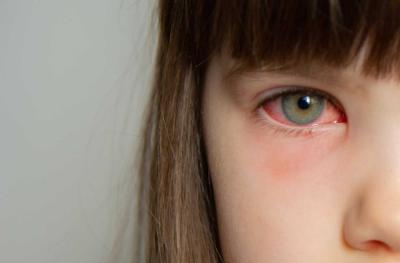Pink Eye

Waking up for school is hard enough but imagine then your child’s eyes are actually glued shut! Unfortunately, this is a common occurrence throughout the year but especially prevalent when kids are in communal settings like school, summer camp, playgrounds or the community pool. But what causes it and what can you do to help? Start by wetting a washcloth with water and remove as much of the dried drainage as possible. Once your child’s eyes are open, contact your medical provider to be evaluated.
What is conjunctivitis?
Conjunctivitis is the medical term for Pink Eye. The conjunctiva is a clear lining over the white part of the eye and the inner eyelids. While it is usually clear, when it gets irritated either by irritation or infection, it turns red/pink. Many cases of pink eye resolve without medicine but because there are multiple different causes, some of which do not get better on their own and can be potentially harmful to the eye, it is important to be checked by a medical provider.
Viral
Viral pink eye can exist with other viral symptoms (nasal congestion, cough, sore throat, fever) but eye redness may also be the only symptom. The drainage tends to be thin, clear and tear-like and there may be a sensation of grittiness or burning. Like other viral illnesses, symptoms improve on their own with time – usually peaking around day 3-4 and gradually improving over the course of 7-10 days. Morning drainage tends to be the symptom that persists after redness resolves. While there is no specific treatment, warm compress and saline eye drops can be helpful for symptomatic relief. A special consideration with viral conjunctivitis is infection caused by the herpes virus, which is why it is important to be evaluated by a medical provider as these cases should be evaluated ultimately by an eye specialist.
Bacterial
The distinguishing feature of bacterial pink eye is the drainage. The drainage is darker in color (green/yellow), thicker, stickier and more pus-like compared to either viral or irritant/allergic pink eye. The drainage also tends to come back much quicker after wiping sand may require wiping every 20-30 minutes. A special consideration with bacterial pink eye is that some of the bacteria that cause pink eye also cause ear infections. Most cases of bacterial conjunctivitis are treated with topical antibiotics (either eye drops or ointment) but if there is an ear infection present, it is best treated with oral antibiotics.
Allergic
There are two distinguishing features of allergic pink eye – aside from presence of other allergic symptoms like sneezing and runny nose. First, the most common sensation reported is itchiness. Second, there is nearly always bilateral (both sides) involvement. Drainage appears like viral pink eye with excess tearing as most common. Treatment is mainly symptomatic using topical antihistamines (eye drops), oral antihistamines (i.e., Zyrtec, Claritin) and cool compress to help with itch sensation.
Others
All conjunctivitis causes a red eye but not all red eyes are conjunctivitis. Other considerations include trauma (i.e., corneal abrasion or subconjunctival hemorrhage), glaucoma, irritants (i.e., chlorine) or infections involving other structures of the eye. All of these can be distinguished from pink eye by a medical provider, but early recognition is important as some may require urgent and/or specialized treatment.
Newborn
There are special considerations regarding pink eye in newborns. It is first important to distinguish true conjunctivitis from a clogged tear duct as both can be associated with drainage and matted eyelashes. Once it is established that your newborn has true conjunctivitis, it is important to know when symptoms began and possible exposures to more accurately diagnose.
TLDR: Here’s a summary:
1. Conjunctivis = Pink Eye (both in name and appearance). There are infectious causes (viral, bacterial) and non-infectious (allergic/irritant) but not all red eyes are Pink Eye.
2. Infectious causes (viral, bacterial) are highly contagious. Handwashing and keeping shared surfaces clean is very important. Also trying to dissuade your child from scratching/touching their eyes can help prevent further spread.
3. Because pink eye is highly contagious, it is safest to stay home from daycare/school until drainage and redness subsides. If pink eye is determined to be bacterial, it is safe to return to daycare/school after using antibiotics for 24 hours.
4. Not all pink eyes need antibiotics! Some will get better on their own while others require more specialized treatment.
5. There are special considerations regarding newborns. When in doubt, get the eyes checked out!
